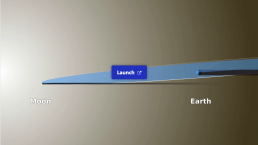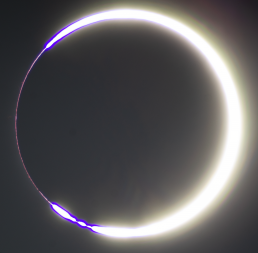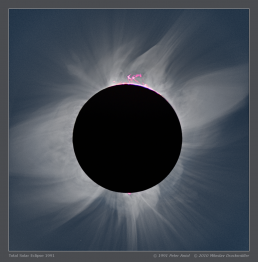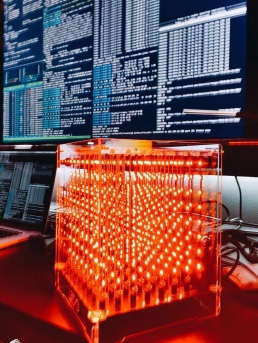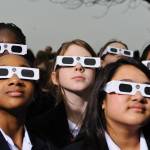Lesson Plan: What and When is Solar Eclipse Maximum?
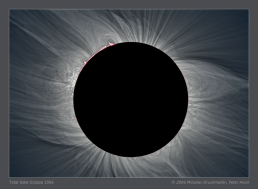

Lesson Plan:What and When is Solar Eclipse Maximum?
Created in collaboration with Tracey Kline, Lynn Public Schools, Lynn, MA
Grade Level: Middle School, NGSS: MS-ESS1-1 Earth’s Place in the Universe.
NGSS STANDARD
MS-ESS1-1: Develop and use a model of the Earth-Sun-Moon system to describe the cyclic patterns of lunar phases, eclipses of the sun and moon, and seasons. (Clarification Statement: Examples of models can be physical, graphical, or conceptual.)
LEARNING/ CONTENT/ LANGUAGE OBJECTIVE:
Students will be able to research the percentage of the eclipse in 3 locations and draw the eclipses from those locations.
LANGUAGE DEMAND:
Essential / Academic Vocabulary: annular eclipse, annularity, corona, maximum phase, total solar eclipse, totality
LESSON STRUCTURE
Lesson Beginning / Frame the Learning
(Clear entry routine, Do-Now, Activator, etc.; Frame the lesson by sharing and explaining lesson objective, agenda, and goals)
Differentiation
What supports and scaffolds am I providing based on the WIDA can-do descriptors?
![]()
![]()
![]()
![]()
![]()
![]()
![]()
![]()
![]()
![]()
- Images are in the Lesson Slides that are provided in Lesson Resources below.
![]()
![]()
![]()
![]()
![]()
![]()
![]()
![]()
![]()
![]()
![]()
![]()
![]()
![]()
- Provide word bank and sentence starters for students who need it.
In picture 1 I notice ….
In picture 2 I notice …
I wonder …
Resource: WIDA can-do descriptors
Lesson Middle
(I do- teacher directed; We do- practice with the teacher; You do- partner/small group application with teacher support)
* Revisit language objective and agenda; formative assessment- check for understanding (intervention and extension opportunities available)
Differentiation
What supports and scaffolds am I providing based on the WIDA can-do descriptors?
![]()
![]()
![]()
![]()
![]()
![]()
![]()
![]()
![]()
![]()
- Video provided in Lesson Resources below.
![]()
![]()
![]()
![]()
![]()
![]()
![]()
![]()
![]()
![]()
- Text provided in Lesson Resources below.
![]()
![]()
![]()
![]()
![]()
![]()
![]()
![]()
![]()
![]()
![]()
![]()
![]()
![]()
![]()
![]()
![]()
![]()
![]()
![]()
- Graphic Organizer provided in Lesson Resources below, one for 2023 annular and one for 2024 Total.
![]()
![]()
![]()
![]()
![]()
![]()
![]()
![]()
![]()
![]()
- Annular Solar Eclipse: https://www.timeanddate.com/eclipse/solar/2023-october-14
- Total Solar Eclipse: https://www.timeanddate.com/eclipse/map/2024-april-8
![]()
![]()
![]()
![]()
![]()
![]()
![]()
![]()
![]()
![]()
- Annular Solar Eclipse: https://www.timeanddate.com/eclipse/solar/2023-october-14
- Total Solar Eclipse: https://www.timeanddate.com/eclipse/map/2024-april-8
- Graphic Organizer is provided in Lesson Resources below.
![]()
![]()
![]()
![]()
- Pre-fill in some of the information in the Graphic Organizer for students ahead of time.
- Decrease the number of locations being researched with the student’s eclipse location as the highest priority.
![]()
![]()
![]()
![]()
Pairing strategy: Partner earlier proficient ELs with later proficient ELs or native English speakers.
Resource: WIDA can-do descriptors
Lesson End
(You do- independent application; Summarize learning; Clear exit routine)
* Formative assessment-exit ticket, check for understanding, etc.
![]()
![]()
![]()
![]()
![]()
![]()
![]()
![]()
![]()
![]()
FORMATIVE ASSESSMENT
How am I measuring success? (Connection to your Content/ Language objective)
Teacher can measure student success by collecting the students’ research information. The most important part to pay attention to is the information they found regarding the location they will be at for the eclipse.
LESSON RESOURCES
- What is Solar Eclipse Maximum? LESSON PLAN (Google Doc): When you open this link you will be prompted to make a copy of the Google document. This will allow you to download, print, and/or edit the lesson plan to best meet your needs.
- What is Solar Eclipse Maximum? LESSON SLIDES (Google Slides): When you open this link you will be prompted to make a copy of the Google slides. This will allow you to edit either of these slide options to best meet the needs of your classroom.
- Do Now HANDOUT: (Google Doc): When you open this link you will be prompted to make a copy of the Google document. This will allow you to download, print, and/edit the Google document to best meet the needs of your classroom.
- Text/Reading “What is Solar Eclipse Maximum?” HANDOUT (Google Doc): When you open this link you will be prompted to make a copy of the Google document. This will allow you to download, print, and/edit the Google document to best meet the needs of your classroom.
- Solar Eclipse Maximum Graphic Organizer 2023 ANNULAR HANDOUT (Google Doc): When you open this link you will be prompted to make a copy of the Google document. This will allow you to download, print, and/edit the Google document to best meet the needs of your classroom.
- Solar Eclipse Maximum Graphic Organizer 2024 TOTAL HANDOUT (Google Doc): When you open this link you will be prompted to make a copy of the Google document. This will allow you to download, print, and/edit the Google document to best meet the needs of your classroom.
- Video Clip | Eclipse Soundscapes (YouTube): – Video clip is also embedded in Lesson slides.
LESSON FEEDBACK
We want to hear from you! If you used this lesson plan or any of these resources, please submit lesson plan feedback via a short form!
Annular Eclipse Features
Annular Eclipse Features
The Eclipse Begins
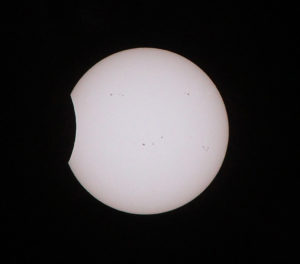

During an annular eclipse, the Moon blocks the Sun, but not completely. From Earth, the Moon does not appear big enough to block out the Sun entirely.
This image is from moments after what is called “First Contact.” At First Contact the Sun appears as a glowing, white disk against a black background. On the left side of the Sun, a small, U-shaped area appears missing from the Sun’s perfect circle shape. This missing area is the Moon as it creeps in front of the Sun slowly starting to block out the Sun’s light. The Moon appears to be taking a bite out of the Sun like a bite out of a cookie.
Usually the Moon’s deep craters make the Moon appear rough. But now, the Sun’s light is so bright that it erases all of the Moon’s features. This causes the Moon to appear black and smooth like glass. The intensity of the Sun’s light makes it unsafe to look at the annular eclipse without always wearing special eye protection.
This image was taken in 2012 by astronomer and science writer Dr. Rick Fienberg. Dr. Fienberg used a digital camera and zoom lens capped with a special-purpose filter to block 99.999% of the Sun’s dangerously bright light. You should never take photos of an eclipse without a special solar filter. The bright light of an eclipse can damage a camera, as well as your eyes! A solar filter helps protect the camera and your eyes. A solar filter fits over the front of a telescope lens and is specifically designed to limit the amount of light without adding color.
Dr. Fienberg has been chasing total solar eclipses around the world for 30 years! He observed and photographed this eclipse from a cruise ship in the Pacific Ocean near Australia.
Annular Phase Begins with Baily’s Beads
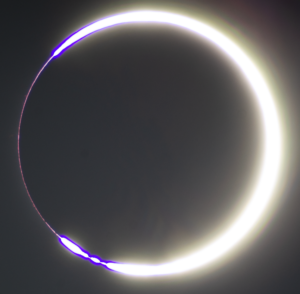

This image is of the phenomenon called “Baily’s Beads.” In this stage the Moon has moved in front of the Sun. The Sun’s light is reduced to a thin C-shape or crescent, shining at the edge of the Moon.
Baily’s Beads look like a few glowing pearls at the ends of the crescent. Baily’s Beads occur because the Moon’s surface is not smooth. It is covered by mountains and valleys. Baily’s Beads are caused by Sunlight beaming between the mountains and through the valleys on the Moon when the Sun begins to peek around the Moon’s edge.
After Baily’s Beads disappear, the Annular Phase begins.
Baily’s Beads are named for an English astronomer named Sir Francis Baily. Sir Francis published his observations after seeing these bright beads of light during the May 15, 1836 annular solar eclipse. And, even though Sir Francis was not the first person to observe this phenomenon, he was the first to publish his observations.
This image was taken by Talha Zia in Sukkur, Pakistan. Talha did not use a solar filter, which can be dangerous. To protect their eyes, Talha did not look into the lens. Talha set up a camera with a telescope on a motorized mount that followed the Sun. To protect the camera lens, Talha limited the amount of light by setting a very short exposure time.
Visit the Rumble Map to explore this image of Baily’s Beads through touch and sound. The absence of light is silent and still. Can you feel and hear where the Sun’s light creates several beads dotted along a ring of light?
Annularity
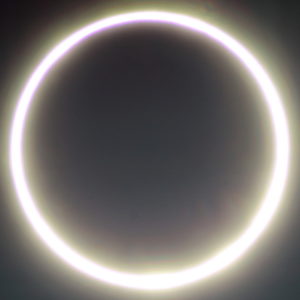

This image is of Annularity, when an annular eclipse is at its maximum point. During Annularity, the dark black Moon appears smooth like glass and blocks the center of the Sun. Only a thin ring of light shines around the edge of the round Moon. As a result, the Sun appears to be a very bright ring of fire rather than a glowing ball. This ring of light may only appear for a few minutes. This spectacular feature is why annular solar eclipses are often called “Ring of Fire” eclipses. This ring shape is also why this type of eclipse is called an “annular” eclipse. This ring shape is known as an annulus in mathematics. The word “annular” means “little ring” in Latin. During an annular eclipse the Moon blocks all but this outer ring of the Sun’s surface. An annular eclipse is just one type of eclipse. Total solar eclipses are another type. During a total solar eclipse the Moon completely covers the surface of the Sun.
This image was taken by amateur astronomer Talha Zia during the June 21, 2020 eclipse in Sukkur, Pakistan. Talha is a member of the Karachi Astronomers’ Society. If you’d like to photograph an eclipse, you will need more than just a telescope or camera! To protect your telescope, AND YOUR EYES, you need to use a special solar filter. This is similar to a very dark piece of glass that fits over the front of your camera or telescope lens. The filter is designed to limit the amount of light without adding color to the image.
Annularity Phase Ends
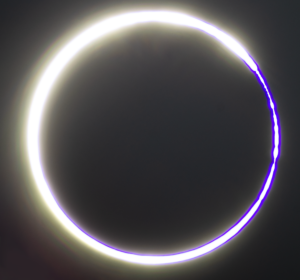

This image was taken as the annular phase ends. The Moon is slowly creeping away from the center of the Sun. As the dark, circular Moon blocks less of the Sun’s bright light, the Sun’s fiery ring of light slowly transforms into a bright crescent shape once again. Depending on your location, Baily’s Beads might be visible again. Baily’s Beads appear like glowing pearls at the ends of the Sun’s glowing crescent.
This image was taken by Talha Zia in Sukkur, Pakistan. Talha did not use a solar filter on their camera, which can be dangerous. To protect their eyes, Talha did not look directly into the camera. Talha set up the camera with a telescope on a motorized mount that followed the Sun. To protect the camera, Talha limited the amount of light by setting a very short exposure time.
The Eclipse Ends
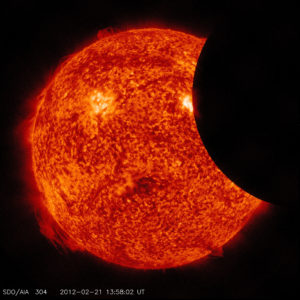

This image is of the end of the annular eclipse. The Moon is slowly moving completely out of the Sun’s way.
While the Moon still appears as a black disk, the Sun is a fiery ball of swirling red and orange. As it moves, the Moon looks like it is taking smaller and smaller bites out of the Sun. In this image, the Moon blocks a small area on the right side of the Sun.
Fourth Contact is the end point of the annular eclipse, when the Moon’s edge moves past the Sun’s edge, and no longer blocks any part of the Sun’s light.
This image was taken by the Atmospheric Imaging Assembly telescope on board NASA’s Solar Dynamics Observatory. This observatory is currently in orbit around the Earth. Its telescope takes eight images like this one every ten seconds. These images help scientists better understand the Sun.
July 11, 2022
Total Eclipse Features
Total Eclipse Features
Corona
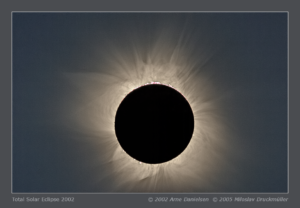

During the totality, the moon completely covers the sun’s glowing orb, and the sun’s outer atmosphere is revealed. As if the moon were the center of a celestial sunflower, the corona appears as soft white petals, massive flumes of faint light that taper out across the sky. Closer to the surface of the moon’s flat ebony circle, the corona is a swirling chaos of loops and flares. Intense fiery lines of light appear to ignite the moon’s black edge.
How to interact with the rumble map
On the rumble map, explore the difference between the moon and the sun’s corona. You will hear/feel variations as your fingers pass over different features of the corona.
Additional scientific info:
The corona is the thin outer atmosphere of the Sun. With temperatures at over 1 million degrees Fahrenheit, it radiates light in wavelengths that are too short for the human eye to see (like X-rays) and that are absorbed by the Earth’s atmosphere. However, the corona reflects some of the white light from the Sun’s photosphere below it. This faint reflection is only seen when the much brighter photosphere is blocked, like during a total eclipse.
Helmet Streamers
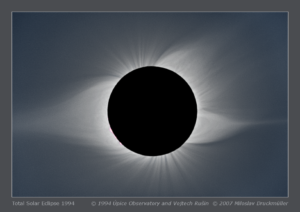

Projections of light from the sun’s outer atmosphere called helmet streamers extend in all directions from behind the moon. In contrast to the black, featureless moon, the pale, wispy streamers appear as delicate as lace. The largest streamers have a tapered shape that resemble flower petals. They extend from opposite sides of the sun, with smaller rays of light between them.
Explanation of what you might feel as you interact:
As you trace your finger along a helmet streamer, you can feel the smooth arches come to long sharp points as they extend from the base of the Sun outward.
Additional scientific info:
Helmet streamers get their shape from two different processes. The arch shape of streamers come from magnetic fields from concentrations of magnetic field on the surface of the Sun extending out into the corona and then arching back down to the surface to connect to other regions of magnetic field of opposite polarity. The long, pointed tops of helmet streamers come from streams of gas flowing out from the corona into interplanetary space forming the solar wind.
Prominence
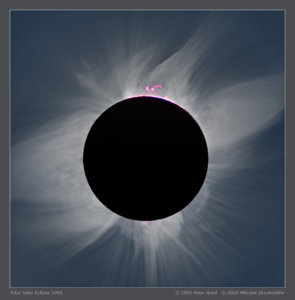

Fiery loops of hot pink light appear to leap off the moon’s black surface. With the sheer white corona as their backdrop, these pink prominences seem to dance above the moon like lines of liquid neon.
Explanation of what you might feel as you interact
You will notice a sharp contrast when you interact with a prominence due to its intense brightness relative to both the moon and the sun’s corona.
Additional scientific info
Prominences are magnetic fields that are filled with very dense material making them much brighter than the surrounding background. The magnetic fields of prominences can be very complicated giving them complex and dynamic shapes.
Baily’s Beads
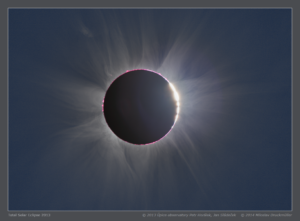

On the right side of the moon, orbs of glowing sunlight shimmer off the edge of the moon’s black disk. Called Baily’s Beads, these final areas of the sun’s light appear as glimmering pearls on a wire, made intensely bright by the absence of light surrounding them.
Explanation of what you might feel as you interact
On the rumble map, explore the difference between the moon, the sun’s corona and Baily’s beads which are intense and irregular.
Additional scientific info
Even this small section of the Sun’s light cannot be viewed without special eye protection. Please use special eclipse glasses or filters if viewing this feature directly on the Sun with your eyes. Baily’s beads are caused because the moon’s surface is not a smooth, perfect sphere. This spectacular feature is caused by rays of sunlight beaming through the ravines and valleys between mountains on the moon.
Diamond Ring
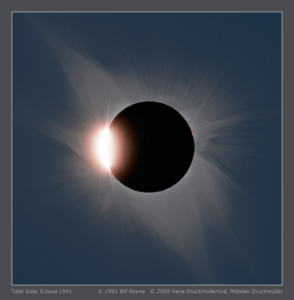

On the left side of the black moon, a sliver of sunlight blasts into view with white-hot intensity. As the area of re-emerging sunlight grows, it resembles a diamond, beaming out its brilliant light from its setting on the circular ring of the moon’s edge.
Additional scientific info
Even this small section of the Sun’s light cannot be viewed without special eye protection. Please use special eclipse glasses or filters if viewing this feature directly on the Sun with your eyes. As the moon barely moves away from the solar surface, the powerful light of the Sun peers around the side of the moon. This light is so intense that even this small fraction of it dominates the sky.
Totality
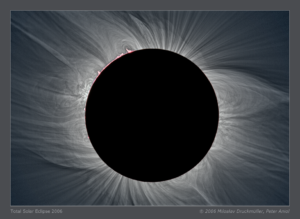

This is the full eclipse, when the moon’s black disk completely covers the sun. Now, in the absence of the sun’s full light, its massive outer corona is revealed. Uniquely visible during a full eclipse, grand flourishes of light called helmet streamers extend in all directions behind the moon’s black disk. At the edge of the moon, the helmet streamers are intensely bright, fading to wisps of ghostly white as they stretch across space, far from the moon, like flower petals.
Explanation of what you might feel as you interact
On the rumble map, explore the difference between the moon and the sun’s corona.
Additional scientific info
You may notice changes in temperature and natural sounds, such a birds and wind during the total eclipse.
During the total solar eclipse, and only during totality, you can view the corona of the Sun without eye protection. The Sun’s outer atmosphere, the corona, is in full display and viewable from the ground. The highly structured nature of the corona is clearly evident. This structure is caused by the Sun’s intense and complicated magnetic fields interacting with the material that makes up the corona. This material is called a plasma, which is like a gas, but is susceptible to magnetic fields. The magnetic fields can then shape the plasma in the corona into the complicated patterns that are viewable during the eclipse.
July 11, 2022
No Opportunities at this Time
No Opportunities at this Time
Unfortunately we do not have any positions to fill at the current time.
Please check back soon as we are always working on new projects to make the universe of learning accessible and engaging for everyone.
Freelance Web Developer
Freelance Web Developer
Eclipse Soundscapes: Freelance Web Developer | Posted: November 2020
Introduction & Background
ARISA Lab, LLC, is looking for quotes from web developer working as independent contractors (1099) for two projects relating to the the Eclipse Soundscapes website. All work is to be done remotely.
The first project is to implement a Spanish language version of the already existing Eclipse Soundscapes website (www.eclipsesoundscapes.org) in a Drupal CMS, set-up automated traffic reports, and contribute to written documentation on work performed. All translations will be provided,
This second project is to implement a database interface based on a previously designed UI, that will be hosted on the already existing Eclipse Soundscapes website (www.eclipsesoundscapes.org) using a Drupal CMS. The developer will also create and implement a “sunset plan” for an interface to retrieve data from cold storage after the project’s completion, and provide written documentation on all work performed.
Developers can provide a quote for either or both of these projects. If bidding on both projects please submit two separate statements of work with quotes. Detailed instructions and lists of deliverables are below.
Application Instructions
Independent contractors should submit the following to vendors@arisalab.org.
- Cover letter – Please highlight and provide examples of relevant experience
- Resume as an independent contractor or capability statement as a company
- Quote – Include cost per deliverable. See Statement of Work and Deliverables.
Statement of Work and Deliverables: Project #1, Eclipse Soundscapes: Bilingual Mobile Application Website
| Deliverable 1: Spanish Language Site | Quote |
| Description: Implement a Spanish language version of the existing Eclipse Soundscapes website (www.eclipsesoundscapes.org) in a Drupal CMS. All translations will be provided. |
|
| Deliverable 2: Automated Reports | Quote |
| Description: Set-up automated traffic reports and dashboard. | |
| Deliverable 3: Documentation | Quote |
| Description: Contribute to webpage documentation based on above work |
|
| Deliverable 4: Hourly Consulting Rate | Quote |
| Description: Consulting/hourly rate for minor website updates |
Statement of Work and Deliverables: Project #2, Eclipse Soundscapes: Citizen Science Project
| Deliverable 1: UI/Database Integration | Quote |
| Description: Implement a previously designed UI (User Interface) for an existing SQL database interface on a Drupal site for active use during project |
|
| Deliverable 2: Sunset Plan | Quote |
| Description: Create and implement a sunset plan for web interface to provide access cold storage digital data |
|
| Deliverable 3: Documentation | Quote |
| Description: Contribute to webpage documentation based on above work |
|
| Deliverable 4: Hourly Consulting Rate | Quote |
| Description: Consulting/hourly rate for minor website updates |
ARISA Blog Article 4
Lorem ipsum dolor sit amet, consectetur adipiscing elit, sed do eiusmod tempor incididunt ut labore et dolore magna aliqua.
Section 1
Lorem ipsum dolor sit amet, consectetur adipiscing elit, sed do eiusmod tempor incididunt ut labore et dolore magna aliqua. Ut enim ad minim veniam, quis nostrud exercitation ullamco laboris nisi ut aliquip ex ea commodo consequat. Duis aute irure dolor in reprehenderit in voluptate velit esse cillum dolore eu fugiat nulla pariatur. Excepteur sint occaecat cupidatat non proident, sunt in culpa qui officia deserunt mollit anim id est laborum.
Lorem ipsum dolor sit amet, consectetur adipiscing elit, sed do eiusmod tempor incididunt ut labore et dolore magna aliqua. Ut enim ad minim veniam, quis nostrud exercitation ullamco laboris nisi ut aliquip ex ea commodo consequat. Duis aute irure dolor in reprehenderit in voluptate velit esse cillum dolore eu fugiat nulla pariatur. Excepteur sint occaecat cupidatat non proident, sunt in culpa qui officia deserunt mollit anim id est laborum.
ARISA Blog Article 3
Lorem ipsum dolor sit amet, consectetur adipiscing elit, sed do eiusmod tempor incididunt ut labore et dolore magna aliqua.
Section 1
Lorem ipsum dolor sit amet, consectetur adipiscing elit, sed do eiusmod tempor incididunt ut labore et dolore magna aliqua. Ut enim ad minim veniam, quis nostrud exercitation ullamco laboris nisi ut aliquip ex ea commodo consequat. Duis aute irure dolor in reprehenderit in voluptate velit esse cillum dolore eu fugiat nulla pariatur. Excepteur sint occaecat cupidatat non proident, sunt in culpa qui officia deserunt mollit anim id est laborum.
Lorem ipsum dolor sit amet, consectetur adipiscing elit, sed do eiusmod tempor incididunt ut labore et dolore magna aliqua. Ut enim ad minim veniam, quis nostrud exercitation ullamco laboris nisi ut aliquip ex ea commodo consequat. Duis aute irure dolor in reprehenderit in voluptate velit esse cillum dolore eu fugiat nulla pariatur. Excepteur sint occaecat cupidatat non proident, sunt in culpa qui officia deserunt mollit anim id est laborum.
MaryKay Severino
Co-Founder, Chief Operating Officer, Education Director
MaryKay is a native Bostonian who grew up in the Somerville/Arlington area. After graduating from Villanova with a Bachelor’s in Economics/Business, she went on to work in the business world, specifically in program management and marketing.
She then went on to earn her Master’s degree in Education and worked in public & private K-12 school systems and universities in Taiwan and South Korea. Upon returning to the Boston area MaryKay worked in the K-12 public school system before leaving to start her own small business as a REALTOR® while also functioning as the Project Manager for the Eclipse Soundscapes Project at the Center for Astrophysics | Harvard & Smithsonian.
Living abroad gave MaryKay a strong understanding of the challenges faced by anyone who communicates differently. For this reason, the Eclipse Soundscapes project was a natural fit. There she used her program management skills to promote, plan, and execute a project which will bring the amazement and wonder of an eclipse to a more inclusive demographic and also developed a deeper love for Science.
Having worked as both a businesswoman and an educator, MaryKay realized that her passion lies in both building businesses and promoting and supporting more inclusive education utilizing the principles of Universal Design. This led her to start ARISA Lab with friend and co-founder, Trae.
September 6, 2020
Dr. Henry "Trae" Winter III
Co-Founder, Chief Executive Officer, Chief Scientist
Trae is a solar astrophysicist who has worked on eight NASA missions observing the Sun. His primary research focus was understanding how energy is released in the Sun’s atmosphere, the corona, and in other stars. Trae spearheaded many efforts to engage the public in scientific discovery, including work with the Montana Space Grant Consortium, the Salish-Kootenai Flathead Lake Reservation, and the Boston Lyrical Opera.
To highlight the spectacular images being produced by the Solar Dynamics Observatory, Trae designed a series of video wall exhibits for the Cooper Hewitt, Smithsonian Design Museum, the Smithsonian National Air and Space Museum, North Carolina State University’s Hunt Library, the Harvard Art Museums’ Lightbox Gallery, and the Museum of Boulder. However, Trae quickly realized many people had no access to the exhibits he was helping create, the blind and visually impaired (BVI).
To make science accessible to everyone, Trae began the Eclipse Soundscapes Project that built a mobile application that would engage all users with the 2017 Total Solar Eclipse. Consultants, who were themselves blind, were included at every stage of the application’s design process. The application used images, spoken word descriptions, sound, and touch to make eclipse features accessible and engaging to everyone as they were occurring.
Based on the success of the Eclipse Soundscapes Project model, Trae and MaryKay Severino founded the ARISA Lab which could quickly assemble highly trained and diverse teams to invent the new technologies and techniques necessary to make scientific exploration effective, accessible, and engaging for everyone.
September 6, 2020
